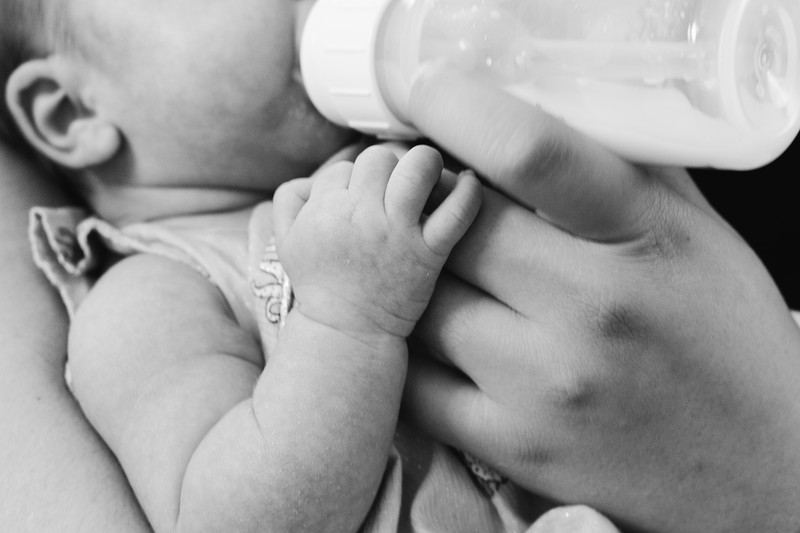How To Help A Baby With Tongue Tie
What exactly is tongue tie?
“Tongue tie – the proper name is ankyloglossia – describes a condition whereby the little bit of skin under the tongue is too short, tight, thick or inelastic, which makes the tongue action needed for suckling, eating and, later, talking, awkward. Many people think that any visible skin under the tongue is tongue tie, but this isn’t true. All humans start womb-life with a frenulum under the tongue, which guides the tongue to grow in the right direction. In the early stages of life, the frenulum is elastic and thin and, as the baby starts to grow its tongue in the womb to practice sucking and swallowing, the frenulum retracts bit by bit until, by the time a baby is born, only a little is left. In about 10% of babies, the frenulum doesn’t retract normally or is too thick, or lacks in normal stretch, so pulls on the tongue, stopping it from moving in the intricate ways needed for normal use. This is tongue tie.” – Rachel Fitz-Desorgher, baby expert at The Baby Show
Are some babies more likely to develop it than others?
“Tongue tie forms in the womb, possibly as the result of a genetic mutation passed on from the parents. It also appears to be more common in boys than girls.” – Lesley Bland, registered midwife at My Expert Midwife
Are there different types of tongue tie?
“There are two main types of tongue tie. Anterior tongue tie happens when the frenulum is too short, and extends too far towards the tip of the tongue. This tends to be clearly visible and is often accompanied by a V-shaped notch at the tip of the tongue. Posterior tongue tie is hidden under the lining at the base of the tongue. This can be harder to diagnose but tell-tale signs include a tongue that dimples in the middle, or a very short tongue.” – Lesley
So, what are the signs to look for?
“If you breastfeed, you may experience sore nipples, mastitis and thrush, whilst babies, whether breast or bottle-fed may lose weight, click noisily and dribble during feeds. They may also have trouble staying on the breast or bottle or get oral thrush. It’s important to know that these issues can also happen without a tongue tie, but all too often, when mums run into issues with painful feeding (or other issues like evening crying, windy-ness or poor weight gain), it can be tempting to self-diagnose tongue tie. Even if the frenulum has not regressed back at all and is still attached to the tongue tip, if it is thin and stretchy enough, this shouldn’t be a problem.” – Rachel
“Because of the short, tight frenulum, you may notice your baby’s tongue appears heart-shaped when moving their tongue forwards. They may also have difficulty attaching to the breast or staying attached for a full feed; they may also feed for a long time, take a short break, and then feed again. At the same time, because of poor latch and attachment during feeding, you may have sore or cracked nipples, or your nipples may appear misshapen like the end of a lipstick, with one side flatter than the other. You may also have a low milk supply, and may feel tired and frustrated, and want to finish breastfeeding earlier than planned.” – Lesley
How is it diagnosed?
“The difficulty is knowing whether your breastfeeding problems are caused by a tongue tie or just a bad latch. For this reason, it’s always best to seek a second opinion, preferably from your midwife or GP. Very often, a tongue tie will be discovered shortly after the birth of your baby during its Newborn Infant Physical Examination (NIPE) where either a midwife or paediatrician will carry out a series of checks on your baby. The practitioner will check your baby’s mouth, including the palate and for tongue tie. However, sometimes a mild tongue tie may be missed and may only be picked up days, weeks, months or even years later, depending on the severity.” – Lesley
Should it always be treated?
“Unless tongue tie is causing problems for either you or your baby, it isn’t always a cause for concern. If you suspect your baby has tongue tie that has been missed, talk to your midwife or GP to rule out other causes or to be referred to a specialist for further investigations. If your baby’s feeding is being affected, very small babies can have their frenulum snipped – this is also referred to as a frenotomy or tongue tie division – in a quick outpatient procedure, but you may need to travel outside your local area to have this done. The procedure is done with either a laser or sterile scissors, it takes just a few seconds and is usually painless as the frenulum has no nerve endings.” – Lesley

How effective is treatment?
“It usually has immediate benefits to the baby through improved feeding, weight gain and general contentment, and to mums with reduced nipple trauma and infections. There tends to be almost no bleeding from the procedure and what little there is will be cleaned up easily with sterile gauze, the wound does not require suturing and babies are more upset about having their mouth opened and their tongue held up than by the actual snip of the frenulum. Most parents whose babies have experienced a frenotomy report a significant improvement in their baby’s feeding and general temperament, with most saying the procedure has completely resolved the problems. There are, however, some babies who will not benefit as well from the tongue-tie division and will continue to have feeding issues. The earlier that a tongue-tie is diagnosed, and treatment can be provided, the more effective the treatment tends to be.” – Lesley
What can be done to prevent recurrence?
“A frenulum can’t grow back, but the cut edges can sometimes stick back together. At the same time, the very deepest part is tricky to reach and, if not divided fully, can continue to cause problems by tugging on the tongue. In these two, albeit very rare, situations, a second frenulotomy may be suggested. Some practitioners will give you exercises to do with your baby to prevent problems after the procedure but there isn’t strong evidence to show these make much difference.” – Rachel
What are your tips for feeding a tongue tie baby?
“Most babies with tongue tie will be able to feed perfectly well, but for some it may affect their abilities, especially those which are breastfeeding, as the tongue is important for latch, attachment and being effective at stripping milk from the breast. They also need good tongue movement to be able to cover their lower gum, which can help prevent the breast and nipple from becoming sore. Often, the symptoms of tongue tie can be improved by working hard to get a deep latch for every feed. When breastfeeding, the flipple technique is great for getting your baby to take more breast tissue into their mouth. This can help many different breastfeeding problems and make it easier for babies to latch as they re-learn breastfeeding following a tongue tie snip. Press the base of your areola so that your nipple points high towards their nose; as the baby starts to latch, allow the nipple to gently flip into the back of their mouth. You want as much of the bottom part of your areola into your baby’s mouth.” – Lesley
What about bottle-fed babies?
“If your baby feeds from a bottle and has tongue tie, start by holding them in a seated position, with one hand behind their head and supporting their back; offer the bottle horizontally, just tipped enough to keep milk in the teat but not enough so that gravity tips the milk into their mouth. Encourage your baby to open their mouth wide by tickling their mouth with the teat and, once they latch, have them take regular breaks which helps them manage the flow of milk more easily.” – Lesley
“It can help to use a teat with a graduated slope so it’s easier for the baby to maintain an airtight latch. Avoid moving up a teat size and keep the bottle neutral while your baby is feeding.” – Emily Whalley, founder of Fox & The Moon
Here, the experts share their final words of wisdom for dealing with a tongue-tied baby…
-
Chat To A Specialist
“Remember the vast majority of babies with feeding challenges don’t have tongue tie but they will have skin under their tongue because a frenulum is a normal part of the anatomy. A tongue-tie specialist will do a thorough check and, even when there is thought to be tongue tie, they will look at non-surgical options first alongside a feeding specialist. Remember – 75% of tongue-tied babies don’t need surgery.” – Rachel - Act Quickly
“If you suspect your baby has tongue tie, seek early diagnosis. The NHS only tends to treat babies up to 16 weeks, although it depends on your trust. You can access private care for up until around 12 months, depending on the practitioner. It can be worth seeking out a practitioner that offers oral play and exercises before and after the treatment, and one that includes a follow-up appointment in their price. Remember the tongue is a muscle so it will need proper rehabilitation following treatment.” – Emily
- Use Nipple Shields
“If you are breastfeeding and have been told a frenulotomy is your best course of treatment, use a nipple shield whilst you are waiting for your appointment. They can make all the difference, and if used properly, will not affect your supply at all.” – Rachel
- Don’t Worry
“If you become stressed, anxious or full of worry, your baby will pick up on the tension and will become upset, too. If you suspect your baby has tongue tie, or has already been diagnosed, make sure you allow plenty of time for feeding. Breast-fed babies may take longer to have a feed as they get tired quicker than a baby who doesn’t have tongue tie.” – Lesley
- Trust Your Instinct
“There are so many myths surrounding tongue tie and its impacts that it can be easy to get swept into the noise. Educate yourself with blogs, books and social media accounts run by experts and always trust your gut. Tongue Tied by Richard Baxter is a great book, and I recommend following Bobby Ghaheri on Instagram as well as @Rockabye_Hub, @Gentle_Births_And_Beyond and @FoxAndTheMoon_Sleep. Always get a second opinion if you have been told your baby isn’t tongue tied but you are experiencing symptoms.” – Emily
For more information visit MyExpertMidwife.com, TheBabyShow.co.uk and FoxAndTheMoon.co.uk
DISCLAIMER: We endeavour to always credit the correct original source of every image we use. If you think a credit may be incorrect, please contact us at info@sheerluxe.com.
All products on this page have been selected by our editorial team, however we may make commission on some products.

/https%3A%2F%2Fsheerluxe.com%2Fsites%2Fsheerluxe%2Ffiles%2Fwebsite-images%2F2025%2F04%2Fnew-parenting-background-image.jpg?itok=au3AjSlw)